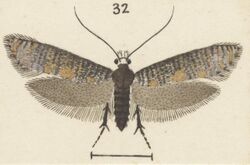Biology:Archyala lindsayi
| Archyala lindsayi | |
|---|---|

| |
| Scientific classification | |
| Kingdom: | |
| Phylum: | |
| Class: | |
| Order: | |
| Family: | |
| Genus: | |
| Species: | A. lindsayi
|
| Binomial name | |
| Archyala lindsayi (Philpott, 1927)
| |
| Synonyms | |
| |
Archyala lindsayi is a species of moth in the family Tineidae. This species is endemic to New Zealand. It is classified as "At Risk, Naturally Uncommon" by the Department of Conservation.
Taxonomy
This species was described by Alfred Philpott in 1927 and given the name Tinea lindsayi.[1] Philpott used a specimen Stewart Lindsay collected at Mount Grey in North Canterbury and named the species in his honour.[2] In 1928 George Hudson discussed and illustrated the species in his book The Butterflies and Moths of New Zealand.[3] However John S. Dugdale is of the opinion that the illustration is an inaccurate representation of the species.[4] In 1988 Dugdale placed this species within the genus Archyala.[4] The holotype specimen is held at the Canterbury Museum.[4]
Description
Philpott described the species as follows:
♂ 11 mm. Head dark bronzy-brown, frons white. Maxillary palpi white. Labial palpi bronzy-brown, terminal segment white. Antennae grey annulated with black. Thorax and abdomen dark purplish-fuscous. Legs greyish-fuscous, tarsi annulated with ochreous-white. Forewings elongate, parallel-sided, costa slightly arched, apex obtuse, termen straight, oblique; leaden-grey; numerous transverse irregular fuscous-black fasciae; space between fasciae, particularly on apical half, filled with bright bronzy-brown: fringes fuscous with a mixed bronzy and dark fuscous basal line. Hindwings dark purplish-fuscous: fringes dark greyish-fuscous.[2]
Distribution
This species is endemic to New Zealand.[5][6] This species is only known from its type specimen and at its type locality of Mount Grey.[7]
Life history
It has been hypothesised that larvae of this species inhabits dead wood boring into it and feeding on the fungus-infected wood.[8][7]
Conservation status
This species has been classified as having the "At Risk, Naturally Uncommon" conservation status under the New Zealand Threat Classification System.[9]
References
- ↑ "Archyala lindsayi (Philpott, 1927)". Landcare Research New Zealand Ltd. http://www.nzor.org.nz/names/51963771-dd45-498c-a047-e667bfa8cd9a.
- ↑ Jump up to: 2.0 2.1 Philpott, A. (1927). "N.Z. Lepidoptera: notes and descriptions.". Transactions and Proceedings of the New Zealand Institute 57: 703–709. http://rsnz.natlib.govt.nz/volume/rsnz_57/rsnz_57_00_008060.html. Retrieved 19 May 2018.
- ↑ Hudson, G. V. (1928). The Butterflies and Moths of New Zealand. Wellington: Ferguson & Osborn Ltd.. pp. 347. http://www.bugz.org.nz/WebForms/ResultDetails.aspx?CurrentDoc=C7E94865-492F-45DA-9777-CC8E1E8B1438&back=true&NewDoc=true&searchType=1&SearchString=G.V.+Hudson.
- ↑ Jump up to: 4.0 4.1 4.2 Dugdale, J. S. (1988). "Lepidoptera - annotated catalogue, and keys to family-group taxa". Fauna of New Zealand 14: 59. http://www.landcareresearch.co.nz/__data/assets/pdf_file/0003/49008/FNZ14Dugdale1988150.pdf. Retrieved 15 May 2018.
- ↑ "Archyala lindsayi (Philpott, 1927)". Landcare Research New Zealand Ltd. http://www.nzor.org.nz/names/51963771-dd45-498c-a047-e667bfa8cd9a.
- ↑ , p. 463, Wikidata Q45922947
- ↑ Jump up to: 7.0 7.1 Patrick, B. H.; Dugdale, J. S. (2000). "Conservation status of the New Zealand Lepidoptera". Science for Conservation (Department of Conservation, New Zealand) 136: 19. ISSN 1173-2946. http://www.doc.org.nz/Documents/science-and-technical/sfc136.pdf. Retrieved 2018-05-19.
- ↑ Pawson, Stephen M.; Emberson, Rowan M. (2000). "The conservation status of invertebrates in Canterbury" (in en). Conservation Advisory Science Notes. ISSN 1171-9834.
- ↑ Hoare, R.J.B.; Dugdale, J.S.; Edwards, E.D.; Gibbs, G.W.; Patrick, B.H.; Hitchmough, R.A.; Rolfe, J.R. (2017). "Conservation status of New Zealand butterflies and moths (Lepidoptera), 2015". New Zealand Threat Classification Series 20: 8. http://www.doc.govt.nz/Documents/science-and-technical/nztcs20entire.pdf.
Wikidata ☰ Q13391887 entry
 |

